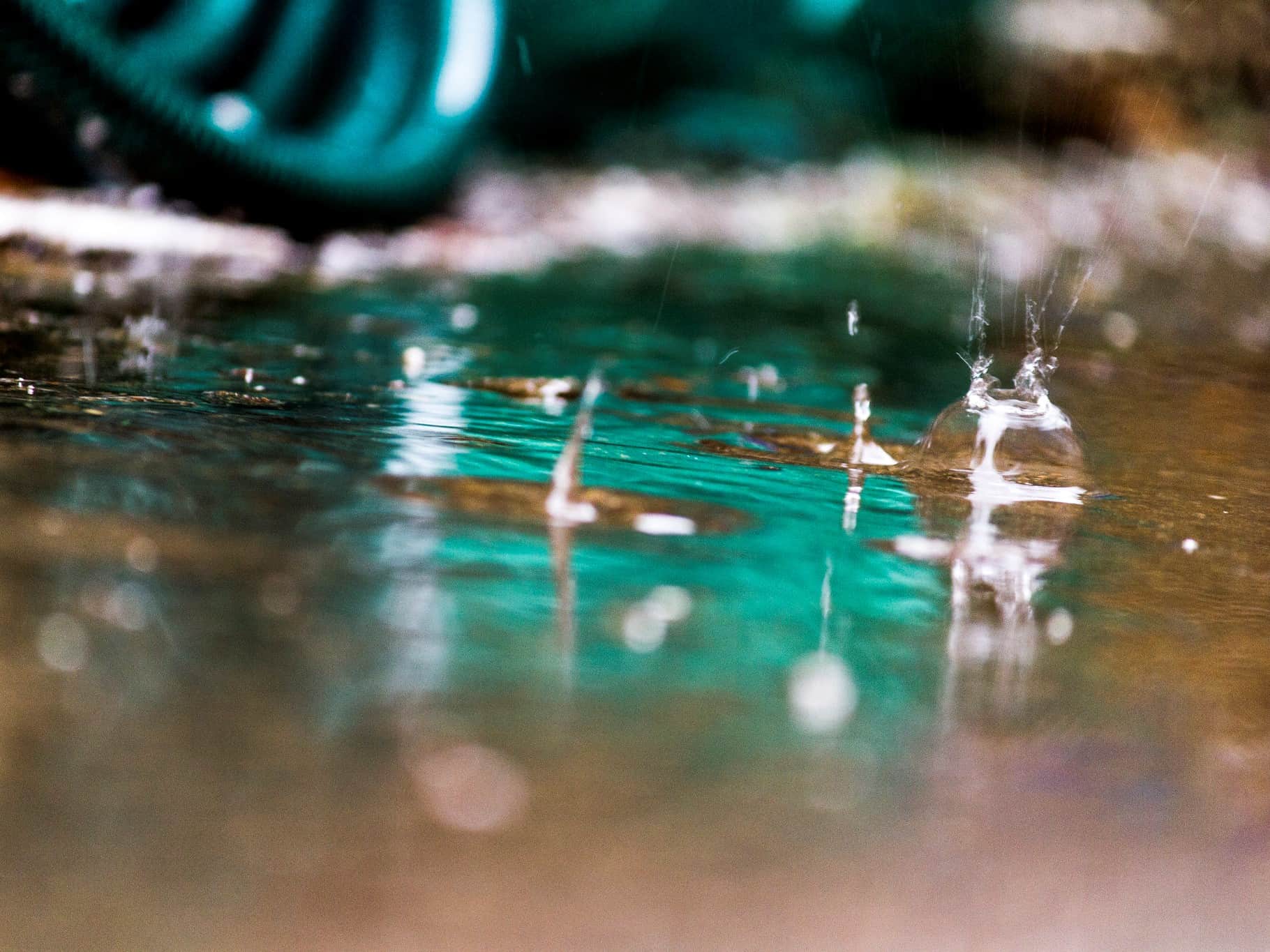Last updated on February 3rd, 2023 at 02:08 pm
Inclement weather is a very common concern for campers, and dome tents are a crowd favorite for their ease, portability, and spaciousness. However, there are just so many on the market, and while all tents resist rain in some way, only a select few are ideal for heavy storms. The best dome tent for heavy rain features high-quality waterproof material, elevated hydrostatic head rating, sealed seams, and good ventilation. We’ve found the best dome tent for heavy rain in the reviews below.
Our Favorite Tents for Bad Weather Are...
After comparing dozens of tents on the market, only a handful are ideal for heavy storms. In addition to the criteria above, we’ve also considered ease of use, portability, and space. These are our front runners for protecting you during inclement weather:
The Best Overall: Big Agnes Copper Spur HV UL
Our Favorite for Backpacking: Nemo Dagger Ultralight Backpacking Tent
Our Favorite Budget Option: Coleman Sundome
Dome tents constructed with heavier denier, higher waterproof ratings, full-flies, and quality ventilation usually rank best.
While all tents resist rain in some way, find out why our selection works best for keeping you dry in our reviews.
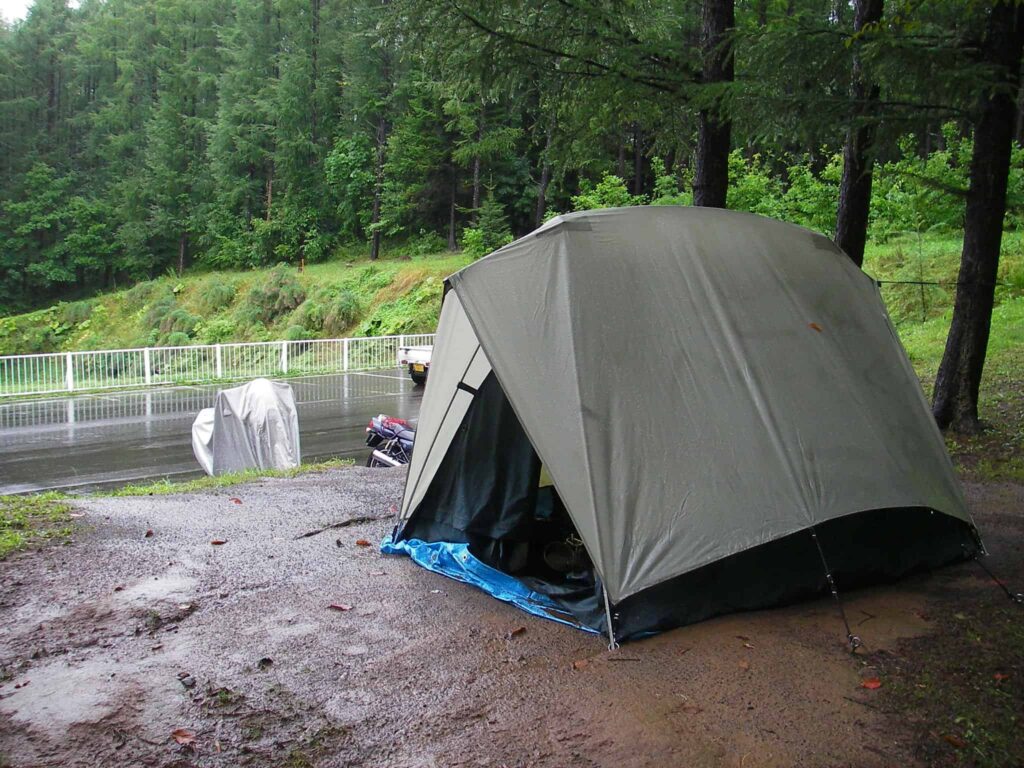
Comparison Table of Dome Tents for Heavy Storms
Firstly, we’ve placed all of our favorite dome tents for heavy rain into the table below for quick reference and comparison.
As you can see, most dome tets look relatively the same. However, there are some important details that set these selections apart from the rest. We go into detail on each in the reviews below.
1. Big Agnes Copper Spur HV UL
First, the Big Agnes Copper Spur HV UL is our favorite overall.
Available from 1-person to 5-person, the Copper Spur HV UL uses a double rip-stop mixed denier nylon.
Additionally, the Copper Spur features a good quality waterproof coating and an ultra light setup.
The Copper Spur uses an ultralight proprietary double ripstop nylon.
As a result, without adding more weight, the mixed deniers provide extra tear strength and added puncture resistance.
Campers and backpackers agree, this tent will be around for many seasons.
I’ve witnessed this tent sustain up to 35 mph winds and rain with no problems during my personal expeditions.
Easy to Set Up
In addition, Big Agnes’ TipLock Tent Buckle simultaneously secures pole tip, rainfly attachment, and stakeout loops, which make setup a breeze.
The Copper Spur features precut reflective guylines and tensioners. Additionally, it has velcro tabs for attaching the fly to the pole structure.
Both of these enhance stability and reliability in storms.
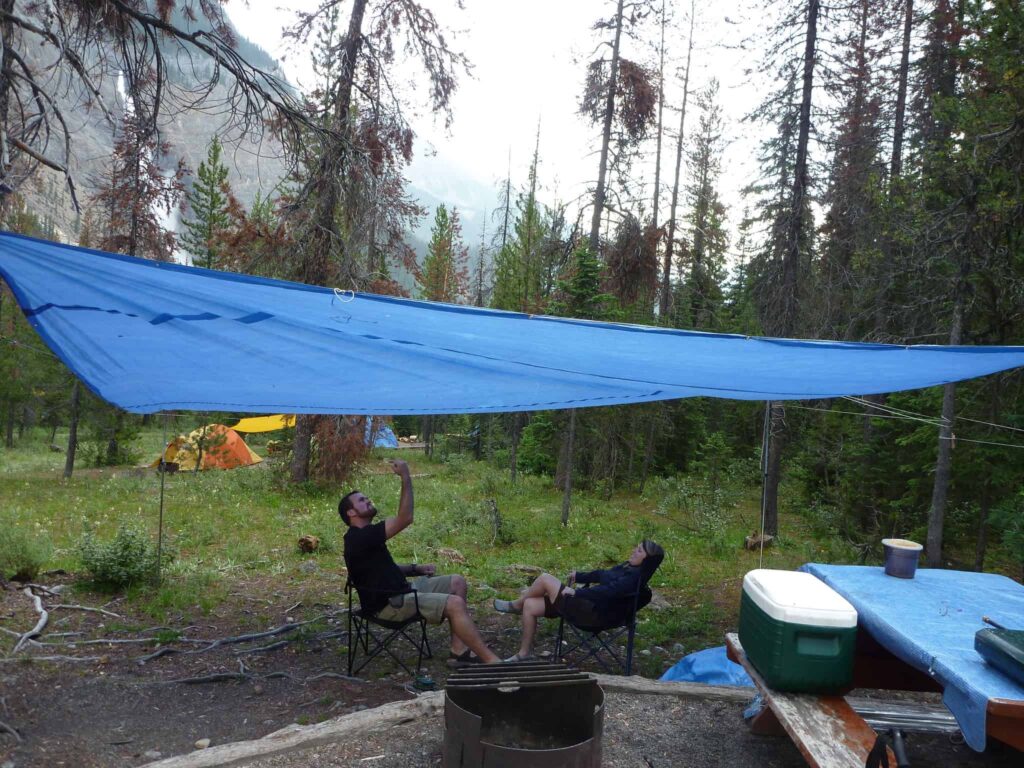
Awning-Style Vestibules and Ideal Ventilation
Additionally, the Copper Spur grants easy access with two doors, each with its own vestibule. Regardless of the size tent (1-5 person), the Copper Spur, makes things easy for campers.
Plus, the awnings-style provide extra protection from the rain.
Utilizing trekking poles or accessory tent poles, you can pitch a protective awning on either side for maximum protection.
Furthermore, the vestibule zippers are protected by storm flaps for even more protection.
We found the vestibules to be great for diverting heavy rain away from our footprint. And thus, away from our beds.
And finally, the Copper Spur offers low vent features along the vestibule doors, and a high fly vent which helps reduce condensation.
Great Option For Backpackers
Finally, Big Agnes has a solid reputation for building lightweight tents. Regardless of the size, this Copper Spur line is light enough to carry on the trail.
For instance, the ‘UL1’, or Ultra Light 1 Person, weighs an incredible 2.6 pounds.
Next, the ‘UL2’, or Ultra Light 2 Person, has a packed weight of 3.0006 pounds.
The ‘UL3’, or Ultra Light 2 Person, has a packed weight of 3.875 pounds.
Furthermore, the UL4 and UL 5 weigh 5.25 and 7.3125 pounds respectively. Which, for a large tent is still incredibly lightweight. And, it’s easy enough to share your pack weight amongst party members.
Pros and Cons of the Big Agnes Copper Spur HV UL
Big Agnes Copper Spur HV UL PROS
- Lightweight with UL1 at 2.6 lbs.
- Added vestibule protection
- Great ventilation
- Plenty of pockets and pouches for storage
- Easy setup
- 2 doors
Big Agnes Copper Spur HV UL CONS
- Subpar HH rating (1200 mm)
- Taped seams rather than sealed
Who is The Big Agnes Copper Spur HV UL Perfect For?
The Copper Spur HV UL works well for anyone looking for ease of use, portability, and adequate space. Additionally, the 4-way DAC pole system provides added strength and stability for withstanding heavy winds. Furthermore, those on the big and tall side find the Big Agnes a great option.
The Copper Spur provides plenty of floor space and headroom. Plus, the vestibule provides added space to protect gear. Despite its less-than-desired waterproof rating and sealed seams, the Big Agnes is a solid overall choice. The craftsmanship of this tent offers superb quality for withstanding heavy rainfall.
2. Nemo Dagger Ultralight Backpacking Tent
Next, our favorite for backpackers is the Nemo Dagger Ultralight Backpacking Tent. The Dagger Ultralight is worth every penny when it comes to protecting you from the elements.
For instance, this tent withstands 60 mph gusts of rain all while keeping you dry.
From wind or sand drifts to snow, the Nemo Dagger is a beast.
We also love that Nemo offers a unique Divvy Cube stuff sack so that hikers can easily share the weight.
Superb Sturdiness and Durable Construction
First and foremost, we’ve seen this tent hold strong beneath 7” of snow on one occasion, and 50 lbs of sand on another because of its intelligent design.
For instance, its low profile and DAC FeatherLite NSL skeletal pole system keep this tent standing against all odds.
The Dagger also features a high abrasion resistance rating increasing its durability.
Furthermore, both the fly and the floor consist of Nemo’s OSMO 2000 mm proprietary blend fabric.
Thus, this tent has supreme resistance against heavy rains and storms of all sorts.

High-performance Proprietary OSMO fabric
Moreover, the Dagger uses Neom’s unique OSMO textile made of poly-nylon ripstop fabric that maximizes performance.
For instance, OSMO uses a composite weave of nylon and polyester.
In fact, OSMO utilizes nylon because it’s lightweight and strong, and polyester because it’s dimensionally stable, it doesn’t stretch, and it’s hydrophobic.
Over time, most nylon absorbs water and stretches out.
However, OSMO fabric not only repels water, but it doesn’t stretch out.
In fact, NEMO fends off water four times longer and stretches three times less.
Two Expansive Trapezoidal Vestibules and Optimal Ventilation
Finally, the Dagger utilizes a unique trapezoidal vestibule which maximizes usable space.
While many tents have vestibules, few provide a footprint between your gear and the ground.
For instance, the Dagger Landing Zone tub provides a barrier that keeps your gear clean and dry during foul weather.
Furthermore, the Dagger features protected strut vents on each vestibule that provide excellent airflow and prevent condensation build-up.
Pros and Cons of the Nemo Dagger Ultralight Backpacking Tent
Nemo Dagger Ultralight PROS
- Quality Construction
- Solid Hydrostatic Head (2000 mm)
- Lightweight at 3.04 lbs.
Nemo Dagger Ultralight CONS
- Zipper Stops leave much to be desired
- Tight For Two
- Small
Who Will Love The Nemo Dagger Ultralight?
Backpackers under 6′ tall will love this dome tent. You can take the NEMO Dagger out on the trail under just about any weather condition. For instance, the Dagger is extremely durable and exceptionally waterproof. It also has a low profile and full-length fly for maximum weather protection.
However, the low profile can make this tent feel a little snug. Although we’ve found the added vestibule space on each side helps compensate for the crowded feeling.
3. Coleman Sundome
Next, our favorite for those on a budget, the Coleman Sundome is our absolute favorite go-to tent for car camping.
Not only does the Sundome offer easy access, great ventilation, and lots of storage, it’s got plenty of headroom.
Additionally, it even features a nice doormat perfect for wet, muddy shoes. Plus, it’s super resilient to heavy rain.
Weathertec System
Firstly, the Sundome is constructed with durable Polyguard two-ply fabric.
Coleman’s WeatherTec system withstands winds up to 35 mph. Plus, it also features tub floors, welded corners, and inverted seams. Which are all essential to keep you dry.
For instance, stitching the seams inside the tent prevents exposure to water. As a result, campers won’t have to worry about water seeping through the stitched holes.
Additionally, the Sundome features a sturdy frame, clip-on pole attachments, and snag-free sleeves make for easy set-up and add extra stability.
Furthermore, despite the half-fly, this tent actually holds up to heavy rain quite nicely. It can take a pounding for several hours and still never leak a drop.
This is by far one of the most popular tents among avid campers.

Exceptional Ventilation
Furthermore, the Sundome provides excellent ventilation components to keep your tent from building up condensation.
This tent features two windows and a ground vent allowing adequate airflow.
Cool air comes through the ground vent while warm air exits through the top.
Additionally, it has two full mesh sides allowing plenty of fresh air.
Two Awnings
Finally, a single pole running from the front of the tent to the back creates two awnings for added protection from the elements.
This allows you to keep your window and door screen open for a nice cross breeze.
Not only does this allow for extra ventilation, but it also keeps you from getting wet.
Pros and Cons of the Coleman Sundome
Coleman Sundome PROS
- Extremely Affordable
- Very Durable
- Excellent Rain Protection
- Great Ventilation
- E-port for easy access to electricity
Coleman Sundome CONS
- Half fly
- Heavy at 7 ½ lbs
Who Will Love The Sundome?
The Sundome is honestly one of my favorite tents to take camping. This tent is great for any type of campers, with the exception of backpackers. It’s perfect for those on a budget, and campers looking for lots of room.
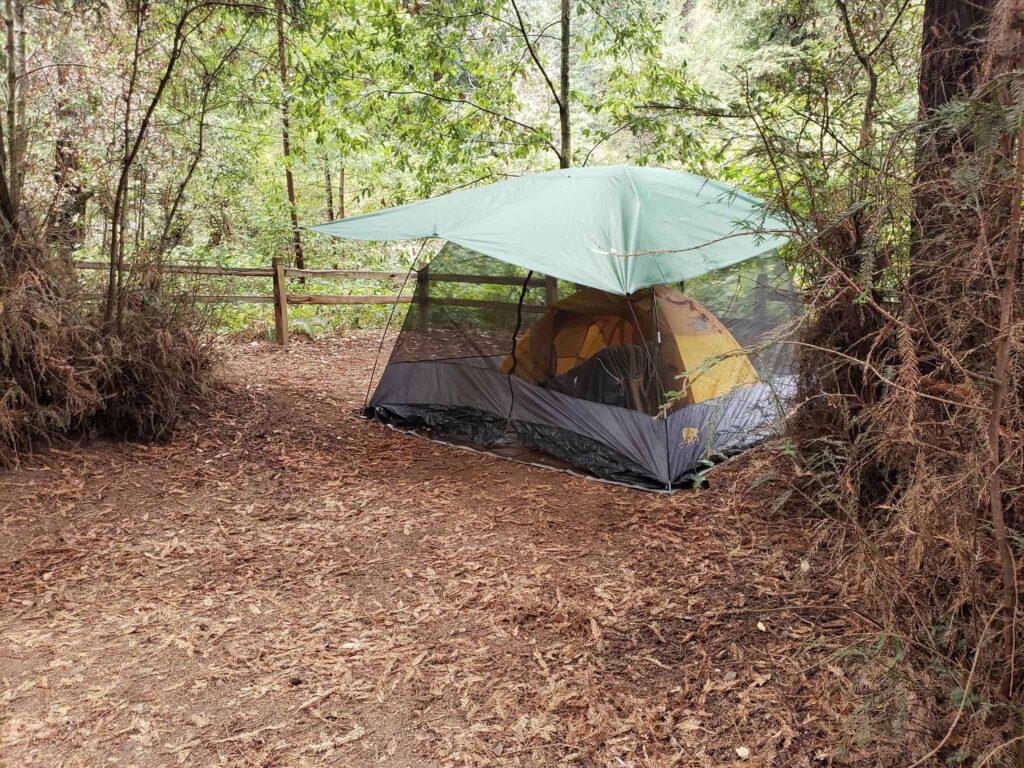
4. Kelty Wireless Car Camping Tent
Another great option for heavy rain is the Kelty Wireless Car Camping Tent. Thw Wireless is made with highly durable materials making it a great option for adverse weather.
Few tents compare with Kelty’s rugged 68-denier polyester fly, walls, and floor. Furthermore, the fly and walls have a hydrostatic head of 1200, while the floor has a rating of 1800 mm. Making this rugged tent storm-worthy.
Quick Corner Technology
Firstly, whether you purchase the 2-person or 4-person, this tent is easy to set up all by yourself.
In fact, the Wireless’ Quick Corner fabric sleeves make setting up this tent really fast.
For instance, campers can just slip the poles into the corner sleeves and it’s that simple. With Quick Corners, the frame stands all by itself. All you have to do is clip on the pole attachments.
It’s a real shame that this 2 person tent weighs 7.3 lbs, because we would love to take this backpacking.
Furthermore, the fly has color-coded webbing for correct orientation. It’s simple to secure the fly by attaching quick-release clips to all four corners.
The Kelty Wireless is one of the easiest tents in the world to set up.
Two Doors And Vestibules
Additionally, low-profile tents often feel cramped. In fact, I always prefer two doors to prevent having to crawl over someone when entering and exiting.
However, the Wireless is designed with two doors, which campers much appreciate for, not only the ease of exit, but also the extra ventilation.
Furthermore, its vestibules make a great addition for storing gear and maximizing space within your tent.
Two doors also allow for a cross breeze and good airflow to prevent condensation build-up. And Vestibules add more protection for heavy precipitation.
Quality Materials
Finally, but definitely most importantly, this tent features some super tough materials.
The Wireless’ durable 68 denier fabric and 1200/1800 mm waterproof rating provide good stability under adverse conditions.
Furthermore, the Wireless can withstand heavy winds, rain, and even hail. It also features fully taped seams preventing leakage.
Finally, this beauty features high bathtub walls and a full fly for maximum protection.
However, there are no windows, only a no-see-um mesh ceiling.
Pros and Cons of the Kelty Wireless Car Camping Tent
Kelty Wireless Car Camping Tent PROS
- Taped Seams
- Great Hydrostatic Head (1200-1800mm)
- Very durable
- Easy and fast setup
- Lots of ventilation
Kelty Wireless Car Camping Tent CONS
- Heavy at 7 lbs 5 oz
Who Would This Tent be Perfect For?
Car campers who aren’t seeking a great deal of room frequently select the Kelty Wireless. It’s durable enough to withstand most bad weather days. In its original form, this tent is too heavy for backpacking. However, upgrading to aluminum poles and divvying the weight can make it doable.
5. MSR Hubba Hubba NX2
Another amazing, high-quality option is the MSR Hubba Hubba NX2.The Hubba Hubba NX2 is lightweight and compact making it an excellent choice for backpackers.
However, it’s roomy for one and tight for two like most 2 person tents. But, this tent is one of the most simple setup and takedowns on the market.
Very Durable Construction
Firstly, the Hubba Hubba is constructed with a 20-denier ripstop nylon body and fly. Plus, the floor is even more durable at 30 denier.
Furthermore, the NX2 aluminum poles are nearly indestructible, as they are made from composite materials.
And, its guy lines have reinforced stitching which thread through sturdy grommets for extra strength.
Great Ventilation
Moreover, the NX2 has a roll-up rainfly great for both stargazing and extra ventilation. So, after the storm passes, you’ll have immediate relief from any humidity.
It also features a kickstand vent when fully enclosed, expanding the breathability of this tent.
Furthuremore, the double doors allow for a good cross-breeze.
Additionally, the tent body has plenty of no-see-um mesh for superb ventilation throughout.
Exceptional Waterproofing
Finally, what we all came here for, thw Hubba Hubba’s resistance against storms.
The MSR Hubba Hubba NX2’s Xtreme Shield waterproofing lasts three times longer than most waterproof coatings.
For instance, its body and fly are constructed with 1200 mm Xtreme Shield, while the floor has an incredible 3000 mm Xtreme Shield rating.
However, when purchasing the NX2, be sure to examine the product specifications carefully.
Apparently, not all of them come with the Xtreme Waterproof coating. Make sure you know what you’re getting before you purchase.
Pros and Cons of the MSR Hubba Hubba NX2
Hubba Hubba NX2 PROS
- Quality materials
- Lightweight at 3.18 lbs.
- Excellent ventilation
- 1200mm waterproof walls and fly
- 3000mm waterproof floor
- Plenty of headroom
- 29 square feet of non-tapered floor space
- 17.5 square feet of vestibule space
Hubba Hubba NX2 CONS
- Some come without Xtreme Waterproof coating
Who Would This tent be Perfect For?
The MSR Hubba Hubba NX2 is great for backpackers looking for a lightweight easy-to-use tent. At 3.81 lbs, the Hubba Hubba is ideal for those on the move.
The MSR Hubba Hubba offers plenty of ventilation throughout to prevent condensation buildup. For those guaranteed clear nights, the MSR also features a minimalist set-up option using only the footprint, poles, and fly. However, the footprint must be purchased separately.
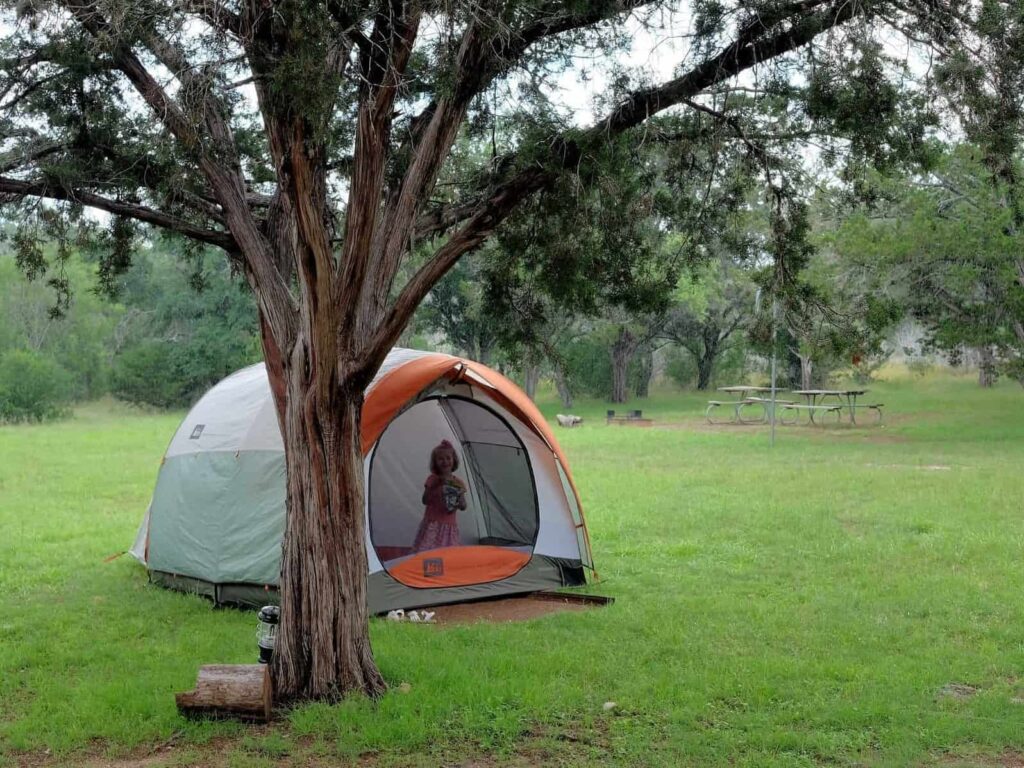
6. Alps Mountaineering Lynx 2 Person Tent
Finally, the Alps Mountaineering Lynx 2 Person Tent is a highly durable option for heavy rainfall.
The Alps Lynx is roomy and offers plenty of headspace for moving around.
With its simple two-pole system and clip-on attachments, the Lynx allows for super easy set-up and tear down. Plus, it’s with two doors and two vestibules, there’s plenty of space.
Superb Construction
Firstly, the Lynx is constructed with a 75D and a 185T polyester fly with added UV resistance.
We not only found this tent to have a quick and easy setup, it stands up to 50mph+ winds and heavy downpours.
The Lynx will be around for many seasons. In fact, this tent also uses generously-sized zippers which we found to be satisfying and sturdy. Which is an area of weakness in many tents.
Furthermore, the Lynx’s floor is coated with a 2000mm HH for superb wet weather protection.
Comfortable And Roomy
Additionally, the Lynx offers plenty of room.
For instance, the Lynx features 37 square feet of floor space, and 20 square feet of vestibule space.
Plus, it provides 46 inches at its peak.
There is also plenty of storage pockets as well as a gear loft. Campers find this to be an exceptional home away from home, not to mention the low price tag.
Good Ventilation
Finally, the Lynx is constructed with half mesh walls providing plenty of ventilation. We found this design to prevent interior condensation the best.
Additionally, the fly features two kickstand vents at the top. Both doors also present zippered windows for an added cross breeze.
A nice feature of the Mountaineering Lynx is that the level of ventilation is fully adjustable depending on weather conditions.
For instance, the vestibule can be fully enclosed, half enclosed, or fully open.
Pros and Cons of the Alps Mountaineering Lynx 2 Person Tent
Alps Mountaineering Lynx PROS
- Factory sealed seams
- Quality Construction
- Great Ventilation
- 2000 mm waterproof floor
- Roomy
- Two doors
- Gear loft and extra storage
- Quick setup
- 3 season
- Setup takes about 4.5 minutes
- Midweight at 5.8 lbs.
Alps Mountaineering Lynx CONS
- Higher profile
Who Would This tent be Perfect For?
The Alps Mountaineering Lynx is perfect for car campers, developed campgrounds, and even backpackers. Although a bit heavy for one at 5.8 lbs., dividing the weight between two makes the Lynx viable for backpacking.
Campers love its two large D-doors for easy entry and exit. Plus, the Lynx 2-person is also super affordable for those on a budget.
Other great tents that almost made the list:
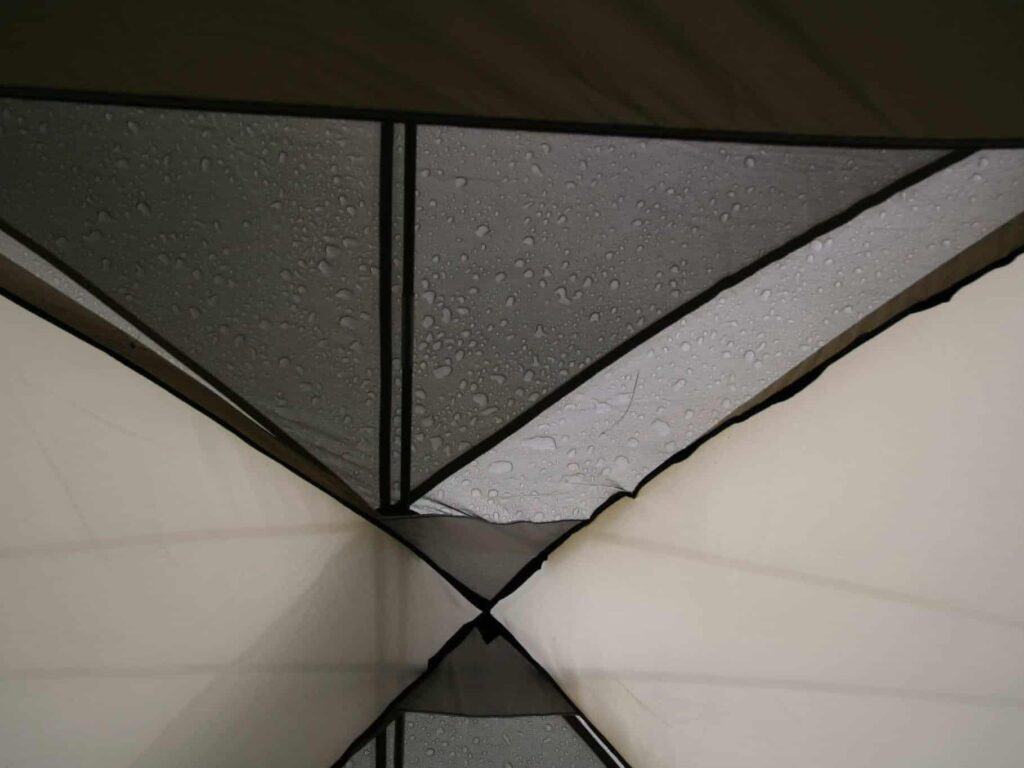
What Makes a Great Dome Tent for Heavy Rain?
Obviously, the best dome tents for heavy rainfall are the ones that remain standing while keeping you comfortable and dry. And, when considering the vast array of tents on the market, we look for ones with these features to find the best:
- Constructed of quality materials. Look for a tent that is made of the strongest polyester or nylon-poly blend for longevity. A higher denier or higher ‘T’ (thread count) will be ideal for resistance against tears. Aluminum/composite poles are also important fordurability.
- Weight: Depending on how you camp you may need a lighter tent. For instance, car campers can get away with choosing a spacious 26 pound tent, while back packers will need a tent that packs down to less than 4 pounds.
- Waterproofing: Tents use a measurement called ‘hydrostatic head’ (or HH) to measure the waterproofing of materials. It describes how high a standing column of water can be placed against a fabric before it begins leaking. You’ll want an HH grade above 1500mm for the rainfly, and between 4000-8000mm for its walls and floor, which will better help with standing water. However, the higher the HH rating, the steeper the cost.
- Seams: Essentially, you’ll see both ‘sealed’ and ‘taped’ seams when inspecting tents. Sealed seams are glued over the stitching and creases, while taped seams have a poly tape layer covering the same seams, creases, and edges. We prefer taped seams for their longevity and durability.
- Ventilation: The best waterproofing will lower a fabric’s breathability. And in a stuffy tent, you’ll experience condensation and dampness which kind of defeats its purpose. Choose a waterproof tent with high-quality mesh windows and vents, which are especially great while paired with a highly durable rainfly.
Whether you’re a backpacker racing an oncoming storm or a family planning a car camping trip this weekend, there’s a perfect tent for you. Try to refrain from all the special bells and whistles of the most pricey tents and focus on HH and ventilation.
Other Ways To Prepare For Inclement Weather
Importantly, you should always test your tent at home before taking it into the wilderness. Checking your tent first allows you the opportunity to correct any unforeseen construction issues, for example.
It’s not uncommon for items like tents to ship without one or two essential parts. A missing pole, stake, or rainfly could easily ruin your entire adventure.
Additionally, there are other ways to better prepare for any weather.
Check Elements for Equipment Failure
First, give it a thorough visual inspection. Make sure there are no rips or tears out of the box if it is new.
Additionally, give your zippers a check to make sure they’re all working properly.
Then, check your guylines to ensure they’re functioning properly.
Once you’ve inspected all the seams, it’s time to test the setup.
Test Your Tent
Once you’ve inspected all the seams, break out the water hose and simulate the worst rain you can imagine. Simply take the time to set your tent up in the backyard.
In addition, focus the spray around the seams, doors, and windows where your tent is most likely to leak.
In fact, some campers opt to actually set their tent up during a rainstorm, which is ideal if you don’t have a backyard. This, in theory, shows you exactly how well your tent can hold up under adverse weather conditions.
Importantly, should you spot any leaks, mark the area. I usually use a Sharpie.
You’ll want to wait until your tent is dry before performing any repairs.
Make Repairs
Once it’s dry, use a commercial seam sealant across any stitching, like Gear Aid Seam Grip, that revealed leaks.
Be sure to wait until the sealant dries before packing your tent away.
Should you spot any leaks in the tent fabric itself, you can use any waterproof patch to seal the leak. Most tents come with their own repair kit. However, because an iron can destroy polyester and nylon, avoid iron-on patch kits.
Once the leak has been patched, spray over it with an additional waterproofing spray, like Nikwax Tent &Gear SolarProof. This should fully waterproof the area.
It’s always a good idea to keep a tent repair kit with you when camping. Needle and thread, tent patches, extra rope for guylines, and duct tape or pole sleeves are always good to have.
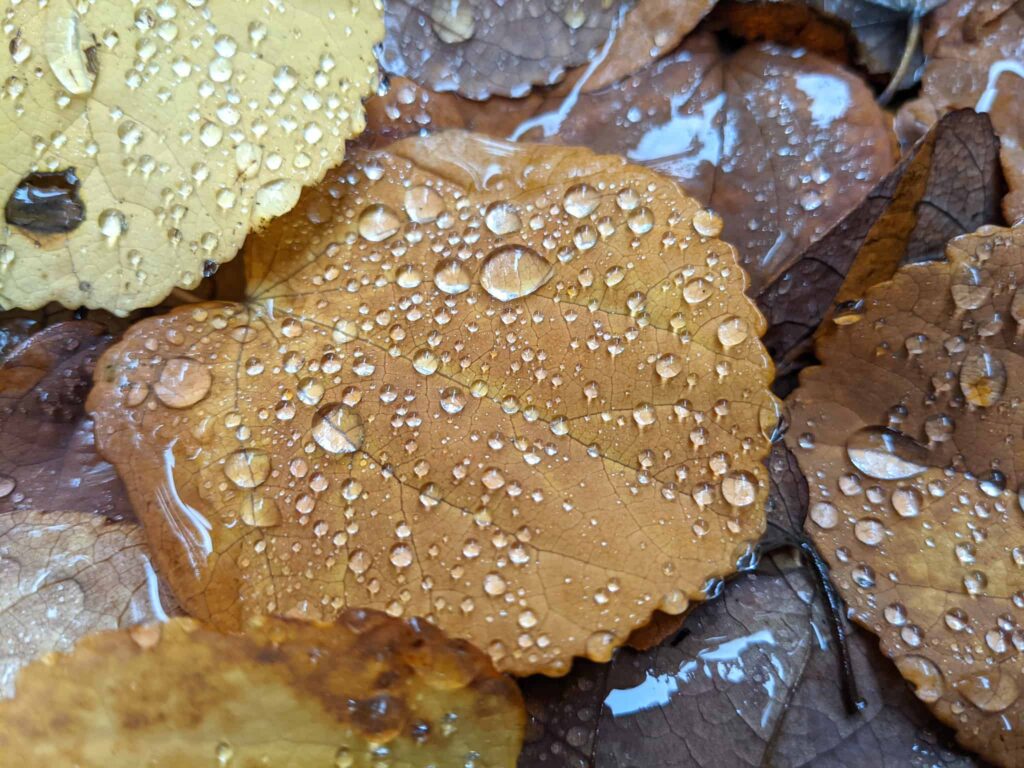
Choose Quick-Drying Clothing
Additionally, campers should wear quick-drying clothing while camping to reduce humidity and condensation inside your tent.
Always look for clothing that provides breathability to prevent moisture build-up. This will also help regulate your body temperature.
Be sure to keep an outer shell that’s waterproof or resistant. Furthermore, lightweight clothing is also a good idea so that it won’t weigh you down if it gets wet.
For instance, choose fabrics like nylon or polyester. Choosing silk in warmer weather works well, but during winter, wool or alpaca would be better options.
Whatever you do, avoid cotton. Cotton retains moisture, is slow to dry, and adds a lot of weight when wet.
Most experienced campers dress in layers in order to add or remove layers as needed. Your base layer should be a moisture-wicking material while your outer shell should provide resistance to wind and rain.
Ideally, your middle layer offers insulation as needed.
Wearing the wrong kind of clothing can actually contribute to added humidity and condensation inside your tent. In fact, any windy outside temperature below 98.6° can drop your core temp to hypothermia levels (below 95°) if you’re drenched by rain (source).
Keep Your Gear Dry
Finally, keeping your gear dry is not only important, but imperative to a successful and enjoyable outdoor adventure.
Just like clothing, wet gear equally contributes to humidity and condensation build-up.
Once your gear gets wet, getting it dry while in the field is next to impossible.
When possible, keep all your gear inside your tent. However, if your tent is on the small side, the next best thing is a vestibule.
When keeping your gear in a vestibule, it’s a good idea to have a barrier between your gear and the ground.
If the ground beneath your gear begins to get wet, your gear will gradually absorb the moisture. A waterproof pack is always your best choice.
Somewhat controversial, many campers swear by having a ground cloth inside their tent. This places a barrier between you and any leak that might occur.
Any water that gets inside your tent stays inside your tent. Having that barrier for both you and your gear goes a long way to keeping both dry.
Gearing Up For the Storm
Campers are tough, and bad weather should never deter you from enjoying the great outdoors. And, with today’s technology finding a quality tent to keep you warm and dry is not overly complicated.
We’ve had a great time finding the best tents for your rainy adventure and feel confident that you’ll never have to worry about bad weather ruining your adventures. So, remember to have fun and also allow your tent to thoroughly dry before packing it up for the trip home or before storage.
Title Image Credit, Best Dome Tent for Heavy Rain: Nikk | (source) | Attribution 2.0 Generic (CC BY 2.0) –reduced file size
Best Dome Tent for Heavy Rain, Image Credit 1: yoppy | (source) | Attribution 2.0 Generic (CC BY 2.0) –reduced file size
Image Credit 2, Best Dome Tent for Heavy Rain: Michael Lawton| (source) | Attribution 2.0 Generic (CC BY 2.0) –reduced file size
Image Credit 3, Best Dome Tent for Heavy Rain: Joel Friesen | (source) | Attribution-ShareAlike 2.0 Generic (CC BY-SA 2.0) –reduced file size
Best Dome Tent for Heavy Rain, Image Credit 4: Under the same moon…| (source) | Attribution 2.0 Generic (CC BY 2.0) –reduced file size
Best Dome Tent for Heavy Rain, Image Credit 5: Davis Prasad| (source) | Attribution-ShareAlike 2.0 Generic (CC BY-SA 2.0) –reduced file size
Image Credit 6, Best Dome Tent for Heavy Rain: Lars Plougmann| (source) | Attribution-ShareAlike 2.0 Generic (CC BY-SA 2.0) –reduced file size
Image Credit 7, Best Dome Tent for Heavy Rain: Lian Chang| (source) | Attribution 2.0 Generic (CC BY 2.0) –reduced file size
Best Dome Tent for Heavy Rain, Image Credit 8: Ruth Hartnup | (source) | Attribution 2.0 Generic (CC BY 2.0) –reduced file size

